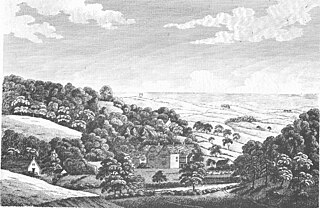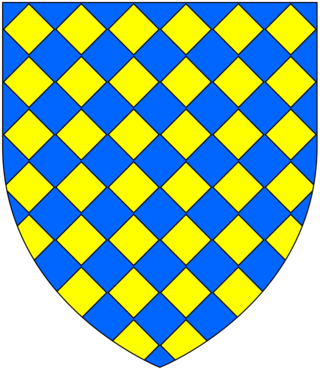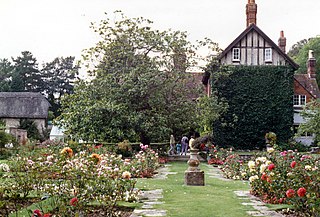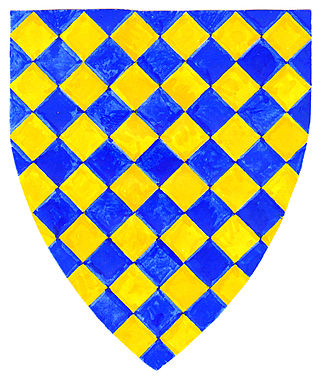
Knighton is a hamlet near to Newchurch on the Isle of Wight. The name should be pronounced as Kay-nighton to avoid confusion with the larger village of Niton, near Ventnor.

Kingston Russell House is a large mansion house and manor near Long Bredy in Dorset, England, west of Dorchester. The present house dates from the late 17th century but in 1730 was clad in a white Georgian stone facade. The house was restored in 1913, and at the same time the gardens were laid out.
The Dillington Baronetcy of Knighton, Isle of Wight in the County of Hampshire was created in the Baronetage of England on 6 September 1628 for Robert Dillington, who was a Member of Parliament. He was succeeded by his grandson, and then by the three sons of the second baronet in turn. All the Dillington baronets except Sir John followed the first baronet into Parliament. The baronetcy became extinct on the death of the 2nd baronet's last son, Sir Tristram, 5th Baronet in 1721.

Mordaunt Fenwick Bisset of Bagborough in Somerset, 22nd Scottish feudal baron of Lessendrum in Aberdeen, Scotland, was a British Conservative Party Member of Parliament and a famous west-country Master of Staghounds.

The Gorges family was a gentry family established in the southwest of England.

Sir Maurice Russell, JP of Kingston Russell, Dorset and Dyrham, Glos. was an English gentleman and knight. He was a prominent member of the Gloucestershire gentry. He was the third but eldest surviving son and heir of Sir Ralph Russell (1319–1375) and his wife Alice. He was knighted between June and December 1385 and served twice as Knight of the Shire for Gloucestershire in 1402 and 1404. He held the post of Sheriff of Gloucestershire four times, and was Coroner and Justice of the Peace, Tax Collector and Commissioner of Enquiry. His land holdings were extensive in Gloucestershire, Somerset, Dorset, Berkshire and Buckinghamshire. He was descended from an ancient line which can be traced back to 1210, which ended on the death of his son Thomas, from his second marriage, as a young man without male issue. Most of his estates, despite having been entailed, passed at his death into the families of his two daughters from his first marriage.

Sir William Russell (1257–1311) was an English nobleman, knight, and holder of a moiety of the feudal barony of North Cadbury, Somerset, but spent most of his life engaged in the administration and defence of the Isle of Wight, where he obtained by marriage the manor of Yaverland. He served as constable of Carisbrooke Castle, and sat in parliament on two occasions, firstly as burgess for Great Bedwyn, Wiltshire, and then for the County of Southampton. As a baron his military service was called on several times by King Edward I Hammer of the Scots.

Sir Robert Dillington, 2nd Baronet was an English politician who sat in the House of Commons at various times between 1659 and 1685.

Warbelton v. Gorges was one of the earliest heraldic law cases brought concerning English armory, in 1347. It concerned the coat of arms blazoned Lozengy Or and azure, that is a field of yellow and blue lozenges. The arms were borne by the unrelated families of Warbelton, from Hampshire, and Gorges, from Somerset, apparently without knowledge of each other or their common usage, until John de Warbelton and Theobald de Gorges served together in the English army at the Siege of Calais in 1346/7. A gentleman's armorial bearings represented his very identity and were of enormous importance to him, both as a matter of family pride and for practical purposes of personal recognition in battle and in legal seals. Warbelton made a formal complaint to the officer appointed by the king to resolve such matters, namely Henry of Grosmont, Earl of Lancaster, seneschal of England, who was commanding the English forces. A 6-man court of honour was convened and the pair were cross-examined, with evidence being sought from knights of their own localities also serving at the siege.

Maurice Denys, Esquire, of Siston, Gloucestershire, was twice Sheriff of Gloucestershire in 1460 and 1461. The Denys family were stated by Sir Robert Atkyns, the 18th-century historian of Gloucestershire, to have provided more sheriffs for that county than any other family.

The Great Budbridge Manor is a manor house just south of Merstone, near Arreton, Isle of Wight, England. Fish ponds on the grounds appear medieval.
Sir Robert Dillington, 1st Baronet (ca. 1575–1664) was an English aristocrat of the Dillington baronets, grandfather to Sir Robert Dillington, 2nd Baronet.

Morton Manor is a manor house originating in the 13th century, in Brading, Isle of Wight, England. It is located 1 mile (1.6 km) southwest of Sandown Road. The fairly small 14th-century house was modified in the 19th century. Constructed of varied materials, it was refurbished and extended in the early 20th century in an Arts and Crafts style. The house has a Tudor fireplace in the dining room, with William De Morgan green glazed tiles, and the manor includes a small museum of rural life.

Wolverton Manor is a manor house in Shorwell, on the Isle of Wight, England. The original house was started by John Dingley, Deputy Governor of the Isle of Wight. The Jacobean style home, built by Sir John Hammond after the death of Sir John Dingley, is the second house built on the site. There is a two-storey porch which features a flat roof and hollow angle columns.

The Denys monumental brass in Olveston Church, Gloucestershire, dates from 1505, and is one of only about 80 surviving monumental brasses in Gloucestershire. It was erected following the death of Sir Walter Denys in 1505, and shows the latter together with his father Maurice Denys, both Sheriffs of Gloucestershire. The Denys family were at various times lords of the manors of Alveston, Earthcott Green, Siston and Dyrham in Gloucestershire.
The Manor of Dyrham was a former manorial estate in the parish of Dyrham in South Gloucestershire, England.
Lieutenant-General Maurice Bocland of Knighton Gorges in the parish of Newchurch, Isle of Wight, was a British soldier and Member of Parliament.

Maurice George Bisset (1757–1821) of Knighton Gorges on the Isle of Wight, and of Lessendrum in Aberdeen, Scotland, 18th Scottish feudal baron of Lessendrum, is famous for his involvement in the scandalous court case involving his mistress Seymour Dorothy Fleming and her husband Sir Richard Worsley, 7th Baronet, of Appuldurcombe House, Isle of Wight. The case was the result of his affair with Lady Worseley, by whom he had a daughter, Jane Seymour Worsley, of whom Richard claimed paternity in order to avoid scandal.
Sir Tristram Dillington, 5th Baronet of Knighton, Isle of Wight was a British Army officer, landowner and Whig politician who sat in the House of Commons between 1707 and 1721.

Baron Gorges was a title created in the Peerage of England for the soldier Sir Ralph Gorges, of Wraxall in Somerset, who was summoned to Parliament as a baron in 1309. On the death of his son without children in 1344, any hereditary title expired.


















